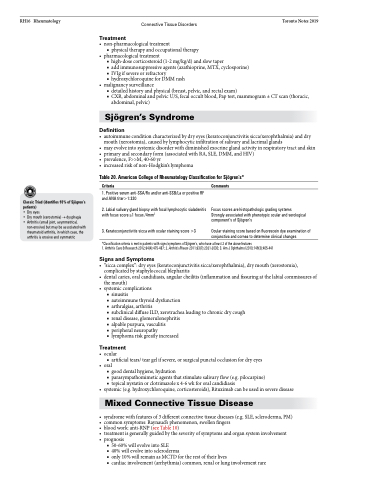Page 1302 - TNFlipTest
P. 1302
RH16 Rheumatology
Connective Tissue Disorders
Toronto Notes 2019
Treatment
• non-pharmacologicaltreatment
■ physical therapy and occupational therapy
• pharmacologicaltreatment
■ high-dose corticosteroid (1-2 mg/kg/d) and slow taper
■ add immunosuppressive agents (azathioprine, MTX, cyclosporine) ■ IVIg if severe or refractory
■ hydroxychloroquineforDMMrash
• malignancysurveillance
■ detailed history and physical (breast, pelvic, and rectal exam)
■ CXR, abdominal and pelvic U/S, fecal occult blood, Pap test, mammogram ± CT scan (thoracic,
abdominal, pelvic)
Sjögren’s Syndrome
Definition
• autoimmuneconditioncharacterizedbydryeyes(keratoconjunctivitissicca/xerophthalmia)anddry mouth (xerostomia), caused by lymphocytic infiltration of salivary and lacrimal glands
• mayevolveintosystemicdisorderwithdiminishedexocrineglandactivityinrespiratorytractandskin
• primaryandsecondaryform(associatedwithRA,SLE,DMM,andHIV)
• prevalence,F>>M,40-60yr
• increasedriskofnon-Hodgkin’slymphoma
Table 20. American College of Rheumatology Classification for Sjögren’s*
Classic Triad (identifies 93% of Sjögren’s patients)
• Dry eyes
• Dry mouth (xerostomia) → dysphagia
• Arthritis (small joint, asymmetrical, non-erosive) but may be associated with rheumatoid arthritis, in which case, the arthritis is erosive and symmetric
Criteria
1. Positive serum anti-SSA/Ro and/or anti-SSB/La or positive RF and ANA titer>1:320
2. Labial salivary gland biopsy with focal lymphocytic sialadenitis with focus score ≥1 focus /4mm2
3. Keratoconjunctivitis sicca with ocular staining score >3
Comments
Focus scores are histopathologic grading systems Strongly associated with phenotypic ocular and serological component’s of Sjögren’s
Ocular staining score based on fluorescein dye examination of conjunctiva and cornea to determine clinical changes
*Classification criteria is met in patients with signs/symptoms of Sjögren’s, who have at least 2 of the above features
1. Arthritis Care & Research 2012;64(4):475-487; 2. Arthritis Rheum 2011;63(7):2021-2030; 3. Am J Ophthalmol 2010;149(3):405-441
Signs and Symptoms
• “siccacomplex”:dryeyes(keratoconjunctivitissicca/xerophthalmia),drymouth(xerostomia), complicated by staphylococcal blepharitis
• dentalcaries,oralcandidiasis,angularcheilitis(inflammationandfissuringatthelabialcommissuresof the mouth)
• systemiccomplications ■ sinusitis
■ autoimmune thyroid dysfunction
■ arthralgias, arthritis
■ subclinical diffuse ILD, xerotrachea leading to chronic dry cough ■ renal disease, glomerulonephritis
■ alpable purpura, vasculitis
■ peripheral neuropathy
■ lymphoma risk greatly increased
Treatment
• ocular
■ artificial tears/ tear gel if severe, or surgical punctal occlusion for dry eyes
• oral
■ good dental hygiene, hydration
■ parasympathomimetic agents that stimulate salivary flow (e.g. pilocarpine) ■ topical nystatin or clotrimazole x 4-6 wk for oral candidiasis
• systemic(e.g.hydroxychloroquine,corticosteroids),Rituximabcanbeusedinseveredisease
Mixed Connective Tissue Disease
• syndromewithfeaturesof3differentconnectivetissuediseases(e.g.SLE,scleroderma,PM) • commonsymptoms:Raynaud’sphenomenon,swollenfingers
• bloodwork:anti-RNP(seeTable10)
• treatmentisgenerallyguidedbytheseverityofsymptomsandorgansysteminvolvement
• prognosis
■ 50-60% will evolve into SLE
■ 40% will evolve into scleroderma
■ only 10% will remain as MCTD for the rest of their lives
■ cardiac involvement (arrhythmia) common, renal or lung involvement rare


